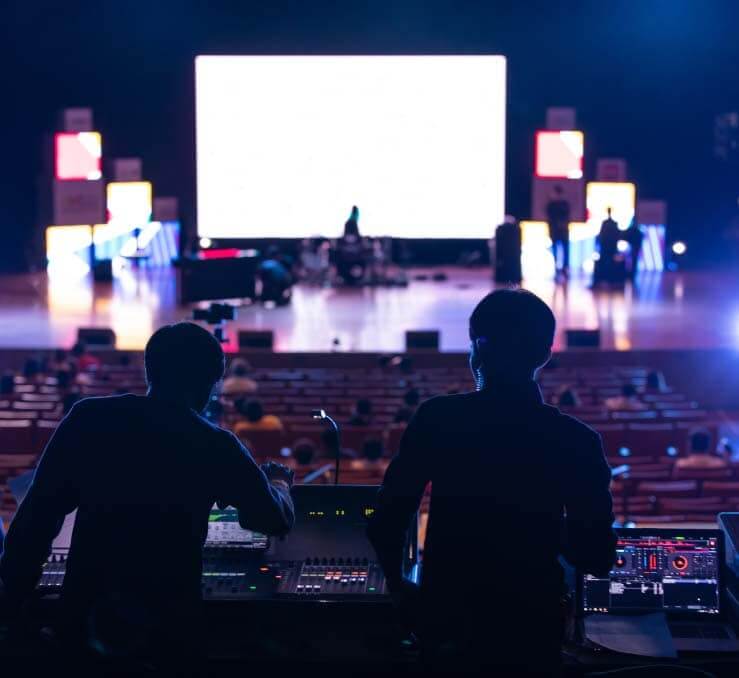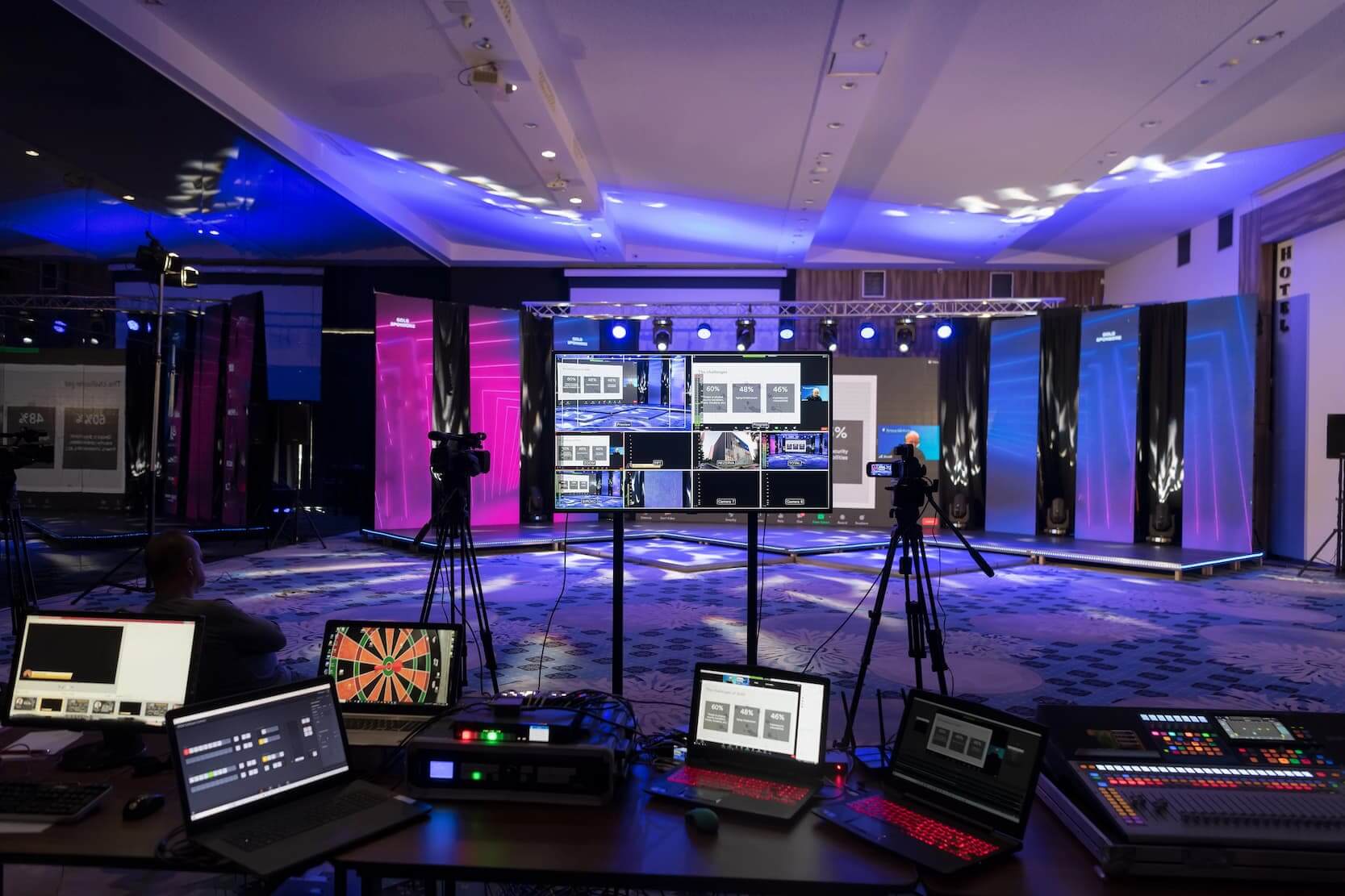The Comprehensive Guide to Audiovisual Equipment: Enhancing Modern Events

In today’s digital age, audiovisual equipment is a cornerstone of successful event management. Companies like Avion Event Management understand that it’s more than just providing sound and visual content; it’s about creating an immersive experience that keeps the audience engaged, focused, and responsive. From corporate conferences and seminars to grand concerts and cultural festivals, audiovisual equipment, expertly handled by providers like Avion Event Management, plays a critical role in making the event a seamless, professional, and unforgettable experience.

What is Audiovisual Equipment?
Audiovisual equipment refers to a wide range of devices that combine audio (sound) and visual (vision) components. These devices are used for recording, playing, projecting, displaying, and fully utilizing both audio and visual media. The main goal of audiovisual equipment is to deliver high-quality content that captivates the audience, provides clarity, and ensures user convenience. Whether it’s for broadcasting a keynote speaker’s message or adding dramatic lighting effects to a stage performance, audiovisual equipment is essential for creating impactful and successful events.
The Three Main Categories of Audiovisual Equipment
Audiovisual equipment can be broadly divided into three categories based on its functionality and purpose:
-
Information Display Systems
Information display systems are designed to project visual content to audiences, whether in a small meeting room or a large auditorium. Depending on the size of the room, usage scenarios, and budget, these systems can vary from small monitors to massive video walls. They are further divided into:
– Collective Information Display Systems:
– Video Walls: A video wall is a large screen made up of multiple thin-bezel LCD displays arranged in a seamless grid. These are ideal for large spaces like auditoriums, control rooms, or exhibitions where dynamic content needs to be visible from all angles.
– LED Screens: Unlike video walls, LED screens are made up of LED modules, providing a seamless display that is perfect for large outdoor and indoor events. Their high brightness and clarity make them excellent for high-visibility displays.
– Projectors + Screens: Projectors paired with projection screens are a cost-effective solution for displaying presentations or videos to a large audience. They are commonly used in classrooms, conferences, and cinemas.
– Duplicate LCD Displays: These displays are typically used in large halls to ensure that information is accessible to those seated far from the stage, allowing everyone to clearly view presentations or live broadcasts.
– Individual Information Display Systems:
– Installation Displays: Used in smaller spaces such as boardrooms or at a round table during meetings, these displays allow for easy interaction between the presenter and participants, providing clear visuals for detailed discussions.
-
Sound Amplification and Processing Systems
Sound is just as crucial as visuals, if not more so, in ensuring the success of an event. The quality of the audio can make or break an experience for the audience. Sound amplification and processing systems are designed to deliver crystal-clear audio to all corners of the room, taking into account the room’s acoustics and the event’s needs.
– Digital Signal Processing (DSP) Platforms: At the heart of any sophisticated audio system is the DSP platform, which allows for precise adjustments of the audio to match the room’s size and acoustics. The platform processes audio signals to ensure that sound is evenly distributed, avoiding echoes, feedback, or distortion. It is essential for large events where the speaker’s voice needs to be heard clearly by everyone in attendance.
– Sound Systems for Different Event Types: Sound systems vary based on the event. For instance, a seminar may require clear vocal amplification through ceiling speakers, while a concert may need a full concert acoustic system with line arrays to provide high-power sound projection across a large area.
-
Switching Systems
Switching systems form the backbone of any integrated audiovisual setup. These systems manage the distribution of video and audio signals across multiple devices and screens, ensuring smooth transitions between different media sources. The equipment used for switching not only converts and transmits signals over long distances but also ensures compatibility between different formats.
– Video Switching: Whether it’s a live stream, a pre-recorded video, or real-time presentations, switching systems ensure that the audience sees exactly what’s intended at the right time. These systems are essential for events where multiple speakers, presentations, and media types are involved.
– Audio Switching: In addition to video, switching systems handle the seamless transition between microphones, music, and other audio sources. This ensures that sound is evenly distributed and that there are no awkward pauses or disruptions during the event.

The Importance of Audiovisual Equipment in Events
Audiovisual equipment is vital in ensuring the success of any event, big or small. It plays multiple roles, from enhancing communication to setting the ambiance of the event. Here are some of the ways audiovisual equipment makes a difference:
-
Carrying the Speaker’s Voice to Every Corner of the Room
In large venues, ensuring that every audience member can hear the speaker clearly is crucial. A well-designed sound amplification system ensures that even those seated far from the stage can hear every word clearly without distortion or echoes.
-
Creating the Right Atmosphere
For corporate seminars, conferences, or even cultural festivals, audiovisual equipment can help set the tone. Proper lighting, background sound, and dynamic visuals can transform a bland space into a lively and engaging environment.
-
Focusing the Audience’s Attention
Whether it’s a business meeting, a product launch, or a keynote presentation, audiovisual equipment helps focus the audience’s attention. High-quality visuals and sound ensure that the key points are communicated effectively, minimizing distractions and enhancing understanding.
-
Avoiding Technical Failures
A poorly set up audiovisual system can be disastrous for any event. Miscommunications, sound disruptions, or visual malfunctions can break the momentum of the event and leave a negative impression on the audience. Carefully planned and professionally maintained equipment prevents these issues, allowing the event to run smoothly.
-
Adding a Touch of Professionalism
Audiovisual equipment reflects the modern, professional standards expected in today’s world. The use of advanced technology and equipment adds prestige and sophistication to any event, boosting its appeal and credibility.
-
Enhancing Interactivity
Audiovisual technology adds a layer of interactivity to events such as seminars, festivals, and corporate meetings. Interactive screens, live broadcasts, sound support, and even lighting effects allow event organizers to engage the audience dynamically. For instance, real-time audience voting, live social media interactions, and interactive displays make the event more memorable.
-
Helping with Promotion and Networking
Audiovisual equipment can help extend the reach of your event through interactive screens, live social media broadcasts, or even apps. This not only enhances the experience for attendees but also creates opportunities for wider promotion and networking.

Types of Audiovisual Equipment for Different Event Needs
Depending on the scale and nature of the event, different types of audiovisual equipment can be used:
– Information Display Equipment: Video projectors, video walls, projection screens, retractable monitors.
– Sound Equipment: Line arrays, concert acoustic systems, ceiling built-in acoustics, background sound systems.
– Congress Systems: Systems that support simultaneous translation, voting, and presentations.
– Lighting Equipment: Rotating light heads, floodlights, and other lighting effects for stage performances.
– Interactive Equipment: Interactive whiteboards, touch screens, and interactive tribunes.
– Videoconferencing Equipment: For real-time interactions between participants in different locations, videoconferencing equipment facilitates virtual engagement.
The Advantages of Renting Audiovisual Equipment
While some businesses may consider buying audiovisual equipment, renting is often the more practical and cost-effective solution, especially for one-time events or irregular use. Renting audiovisual equipment offers several advantages:
-
Saving Money
Purchasing high-quality audiovisual equipment can be expensive, especially when factoring in the costs of regular maintenance and updates. Renting allows you to access top-tier equipment at a fraction of the cost. Additionally, maintenance and repairs are typically included in the rental service, saving further costs.
-
Flexibility in Equipment Selection
Renting audiovisual equipment gives you the flexibility to choose the most suitable devices based on the scale and nature of your event. Whether you’re hosting a small corporate seminar or a large festival, you can easily select equipment that matches your requirements, such as the size of the venue, the theme of the event, or the number of guests.
-
Professional Maintenance and Setup
Most rental companies offer not just the equipment but also technical support and maintenance. This means that professionals will ensure the proper setup and functionality of the equipment, allowing you to focus on other aspects of event management.
-
Avoiding Equipment Obsolescence
Technology evolves rapidly, and purchasing audiovisual equipment may lead to obsolescence over time. By renting, you can avoid the hassle of maintaining outdated equipment and enjoy the latest technology for each event.
-
Convenience
When renting audiovisual equipment, there’s no need to worry about storage, maintenance, or transporting heavy devices. This convenience frees up time and resources, allowing you to concentrate on planning and executing a successful event.
In the UAE, Avion Event Management offers comprehensive audiovisual equipment rental services for events of all sizes. Whether you’re planning a family gathering, corporate conference, or concert, Avion Event Management provides top-notch equipment, professional support, and event planning assistance to ensure your event is a success.
Conclusion
Audiovisual equipment is an integral part of modern event management. Whether for creating an immersive environment, ensuring clear communication, or adding a touch of professionalism, high-quality audiovisual equipment is essential for engaging and captivating your audience. Renting audiovisual equipment provides flexibility, cost savings, and professional support, making it an excellent choice for event organizers looking to deliver memorable experiences. By selecting the right audiovisual solutions, your event will not only meet but exceed the expectations of attendees, leaving a lasting impression.


